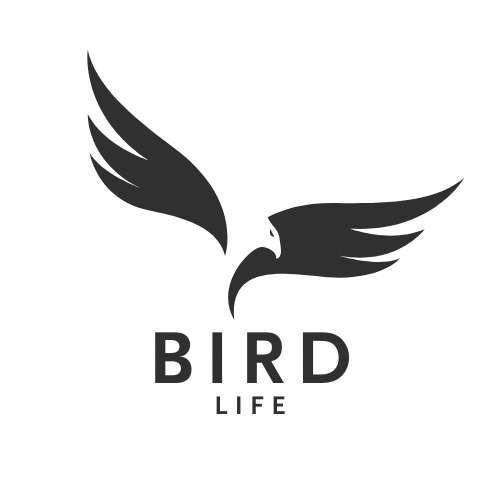The natural world is filled with extraordinary creatures that often leave us in awe of evolution’s creative genius. Among these remarkable animals is the Shoebill stork (Balaeniceps rex), sometimes called the Whale-headed stork—a prehistoric-looking bird that seems to have stepped out of the Jurassic period. With its massive shoe-shaped bill, imposing stature, and eerily statue-like hunting technique, the Shoebill has captivated wildlife enthusiasts worldwide. This enigmatic wading bird, native to the swamps of East Africa, represents one of nature’s most specialized and unusual designs. In this article, we’ll explore the fascinating world of the Shoebill stork, examining everything from its distinctive physical features to its hunting strategies, conservation status, and the cultural significance it holds in its native habitat.
Origins and Taxonomy: A Bird of Unique Lineage

The Shoebill holds a distinctive place in avian taxonomy, being the only member of the genus Balaeniceps and family Balaenicipitidae. Taxonomically, it has puzzled scientists for generations, with its classification shifting several times between stork-like and heron-like categorizations. Modern genetic studies have revealed that the Shoebill is most closely related to pelicans and hamerkops, forming part of the Pelecaniformes order. This taxonomic uniqueness reflects the bird’s evolutionary journey, having diverged from other avian lineages approximately 40 million years ago. The isolation of its genetic lineage helps explain why the Shoebill appears so unusual compared to other modern birds, essentially standing as a living fossil with few close relatives in today’s world.
The Unmistakable Appearance: Nature’s Sculpted Masterpiece
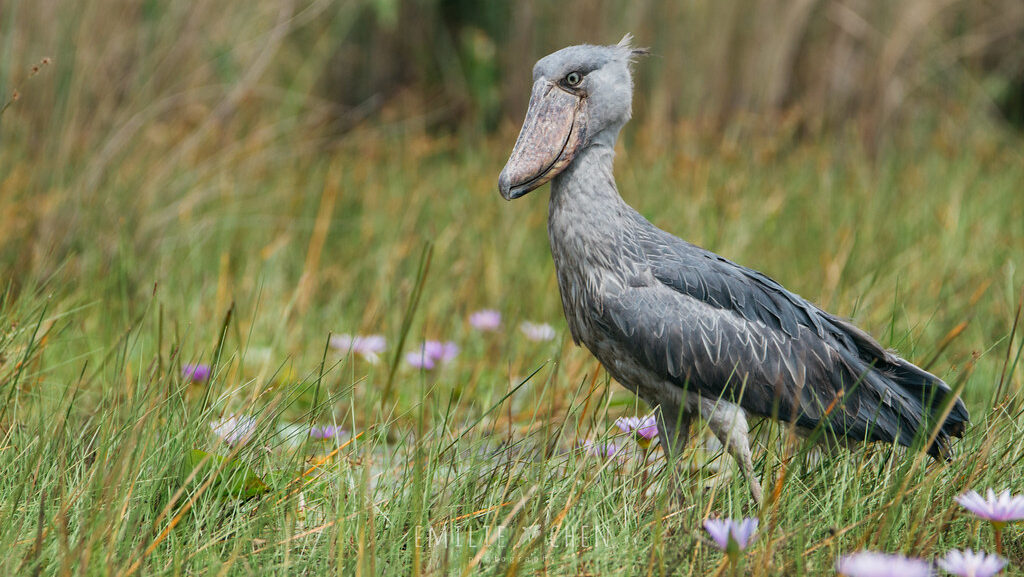
Standing at up to 5 feet tall with a wingspan that can exceed 8 feet, the Shoebill cuts an imposing figure in its swampy habitat. Its most distinctive feature is undoubtedly its massive bill—a structure that resembles a wooden shoe or clog (hence the name “shoebill”) and measures 7-9 inches in length and 4 inches in width. This enormous bill ends in a sharp nail-like hook and features cutting edges that can easily decapitate prey. The Shoebill’s plumage ranges from blue-gray to slate gray, appearing almost bluish in bright sunlight, while its legs are blackish in color. Its eyes have a pale yellow iris that gives the bird an intense, almost menacing stare that many observers find unsettling. When viewed from certain angles, the Shoebill’s prehistoric appearance is so pronounced that it’s often nicknamed the “dinosaur bird” by those fortunate enough to witness it in the wild.
Habitat Preferences: Masters of the Marshland
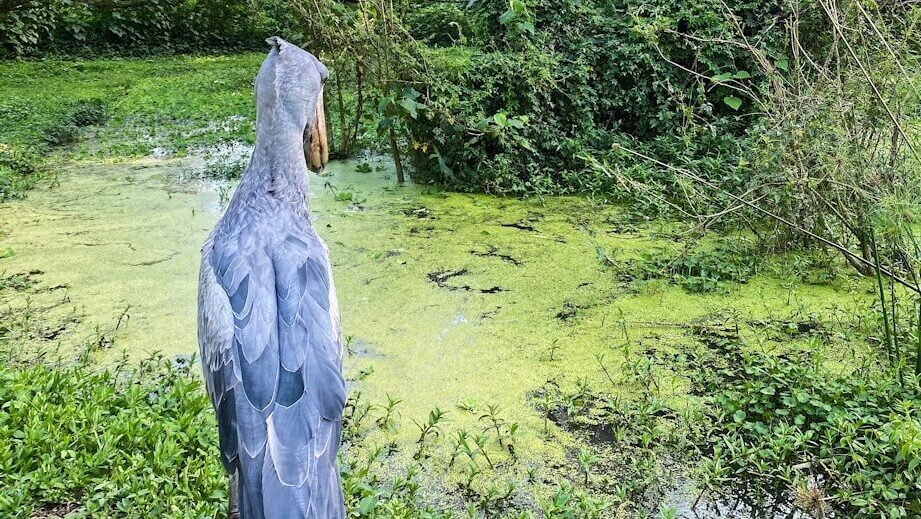
Shoebills are highly specialized wetland birds, demonstrating a strong preference for extensive, dense freshwater marshes and swamps across East Africa. Their primary range includes countries like Uganda, South Sudan, Tanzania, and Zambia, with particularly significant populations found in the vast Sudd wetlands of South Sudan and Uganda’s Murchison Falls National Park. These birds require specific habitat conditions, including areas of both open water and dense papyrus or reed beds that provide crucial hunting grounds. Shoebills generally avoid areas with significant human disturbance, retreating deeper into remote wetlands as human development encroaches on their territory. The birds demonstrate remarkable adaptation to seasonal changes in their wetland habitats, sometimes traveling considerable distances as water levels fluctuate throughout the year to maintain access to suitable fishing grounds.
The Hunting Technique: Patience Personified

The Shoebill’s hunting strategy is one of the most distinctive in the avian world, characterized by extraordinary patience and lightning-fast strikes. These birds often stand motionless for hours, resembling a statue as they wait for prey to move within striking distance. This technique, known as “stand-and-wait” hunting, requires incredible physical endurance and concentration. When a suitable prey item is detected, the Shoebill launches a powerful, vertical strike, plunging its massive bill into the water with such force that it can create a small explosion of water droplets. The strike happens with astonishing speed—taking less than a tenth of a second from initiation to completion—giving prey virtually no opportunity to escape. After capturing prey, the Shoebill often manipulates it in its bill before swallowing, sometimes decapitating larger fish or reptiles with the sharp edges of its bill before consumption.
Dietary Preferences: Specialized Predation
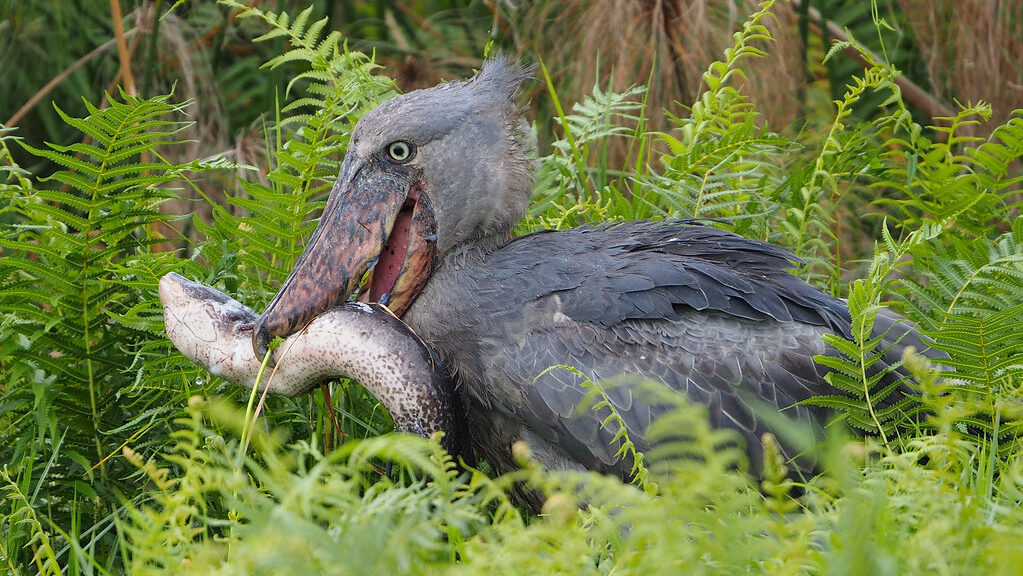
Shoebills are highly specialized predators with a diet centered primarily around lungfish, especially the African lungfish (Protopterus), which can constitute up to 60% of their diet in some regions. These prehistoric fish, which can breathe air and survive in oxygen-poor water, make perfect prey for the specialized bill of the Shoebill. Beyond lungfish, these birds also consume a variety of other aquatic prey, including catfish, tilapia, eels, monitor lizards, snakes, turtles, and even occasional young crocodiles. The size of prey can be substantial, with Shoebills capable of handling fish weighing up to 3.5 pounds. Their specialized bill serves multiple functions during feeding: it can cut through vegetation to access prey, create pressure differentials in muddy water to detect movement, and deliver a precise killing blow to larger animals. This dietary specialization makes Shoebills particularly vulnerable to habitat changes that affect their preferred prey species.
Vocalization and Communication: The Bill-Clapping Ritual
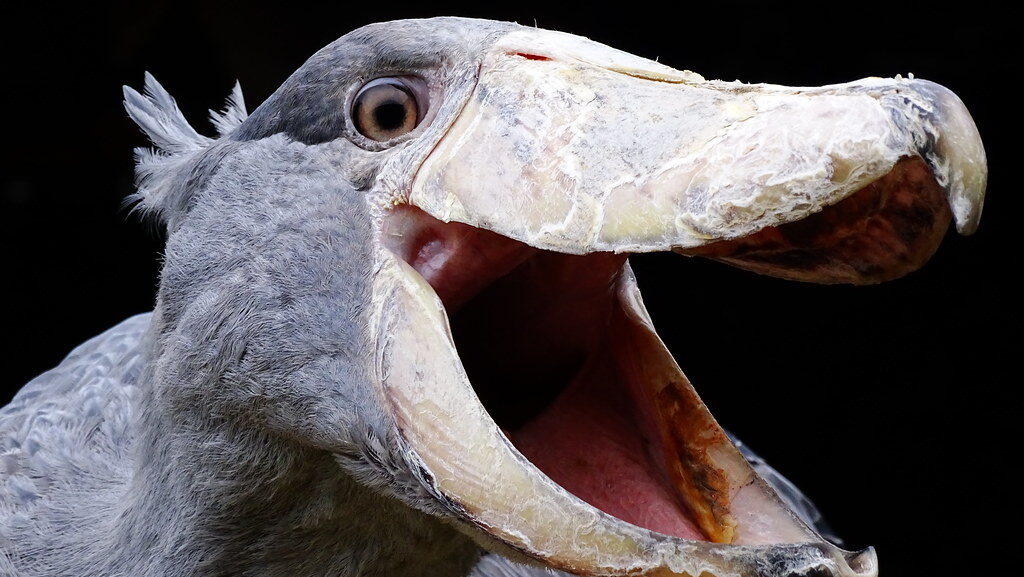
Despite their imposing size, Shoebills are remarkably silent birds, rarely vocalizing except during specific circumstances. When they do vocalize, it’s typically during nesting season or in moments of extreme stress, producing sounds that have been described as reminiscent of machine-gun fire or hollow, booming moans. More commonly, Shoebills communicate through an impressive physical display known as “bill-clapping,” where they rapidly clatter their massive bills together to create a loud, hollow wooden sound that can carry across their wetland habitats. This bill-clapping serves multiple social functions, including courtship display, territorial marking, and greeting between mated pairs. Young Shoebills are considerably more vocal than adults, using high-pitched calls to beg for food and attention from their parents. Researchers have documented that these juvenile vocalizations gradually decrease as the birds mature, eventually giving way to the mostly silent demeanor characteristic of adult Shoebills.
Breeding Behavior: Devoted Yet Ruthless Parents
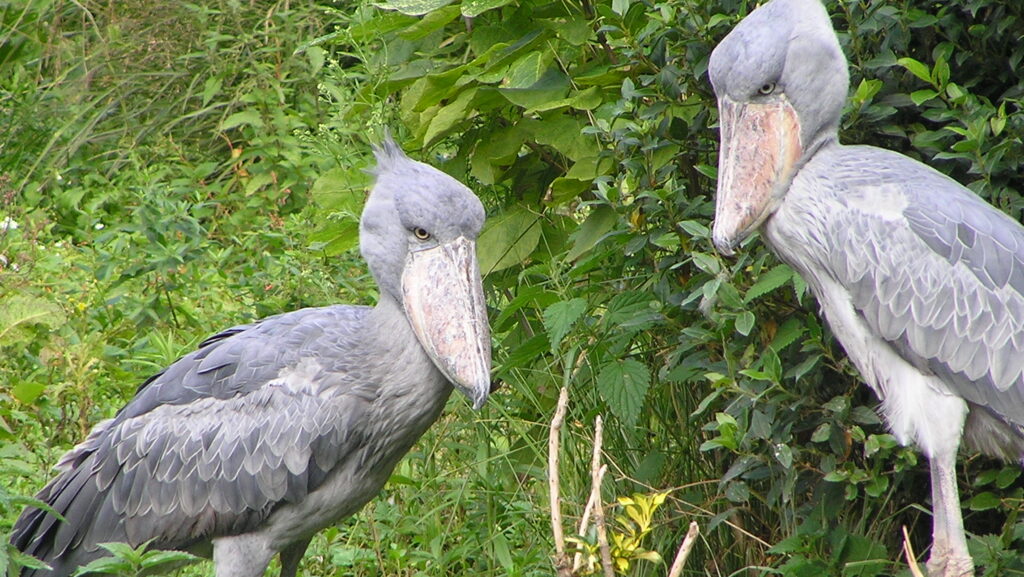
The breeding behavior of Shoebills reveals a fascinating contradiction—extreme parental devotion combined with brutal sibling competition. Shoebills are monogamous birds that form long-term pair bonds, with breeding typically occurring during the dry season when water levels recede and fish become more concentrated. The nest is a large platform of aquatic vegetation built atop floating vegetation or small islands, typically measuring 1-2 meters in diameter. Females lay 1-3 eggs, with incubation duties shared between both parents over a period of about 30 days. What makes Shoebill parenting particularly notable is the practice of “obligate siblicide,” where the stronger chick systematically attacks and often kills its younger sibling with the parents’ apparent consent. This seemingly harsh strategy ensures that resources are concentrated on raising a single successful offspring rather than risking the survival of all chicks in challenging environmental conditions.
Conservation Status: A Vulnerable Icon

The Shoebill is currently classified as “Vulnerable” on the IUCN Red List, with population estimates suggesting fewer than 8,000 adult birds remain in the wild. This precarious conservation status stems from multiple threats, including habitat destruction through drainage of wetlands for agriculture, human settlement, and resource extraction. The illegal wildlife trade poses another significant threat, with Shoebills fetching high prices in international markets for zoos and private collections. Climate change presents perhaps the most insidious long-term threat, as shifting rainfall patterns alter the hydrology of the wetlands upon which Shoebills depend. Conservation efforts have intensified in recent years, with protected areas established in key Shoebill habitat across East Africa and community-based conservation programs working to engage local populations in protection efforts.
Cultural Significance: From Ancient Egypt to Modern Conservation
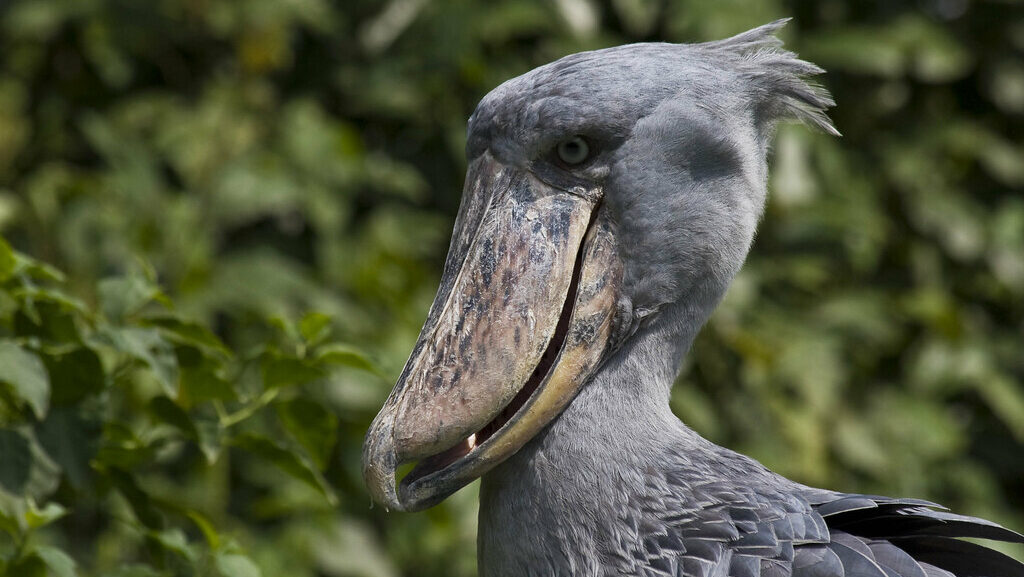
Throughout history, the Shoebill has held significant cultural importance in various African societies, often being viewed with a mixture of reverence and fear. In ancient Egypt, images resembling Shoebills appear in hieroglyphics, suggesting these distinctive birds were known to early civilizations along the Nile. Among certain East African communities, traditional beliefs hold that Shoebills bring either good fortune or bad omens, depending on local folklore. In Uganda’s Mabamba Bay, a traditional stronghold for Shoebills, local fishing communities have transformed their relationship with these birds from one of indifference or occasional persecution to active protection, recognizing their value for ecotourism. This cultural shift represents an important conservation success, as communities increasingly see economic value in protecting rather than exploiting these remarkable birds.
Behavioral Quirks: The Stork That Acts Like a Statue
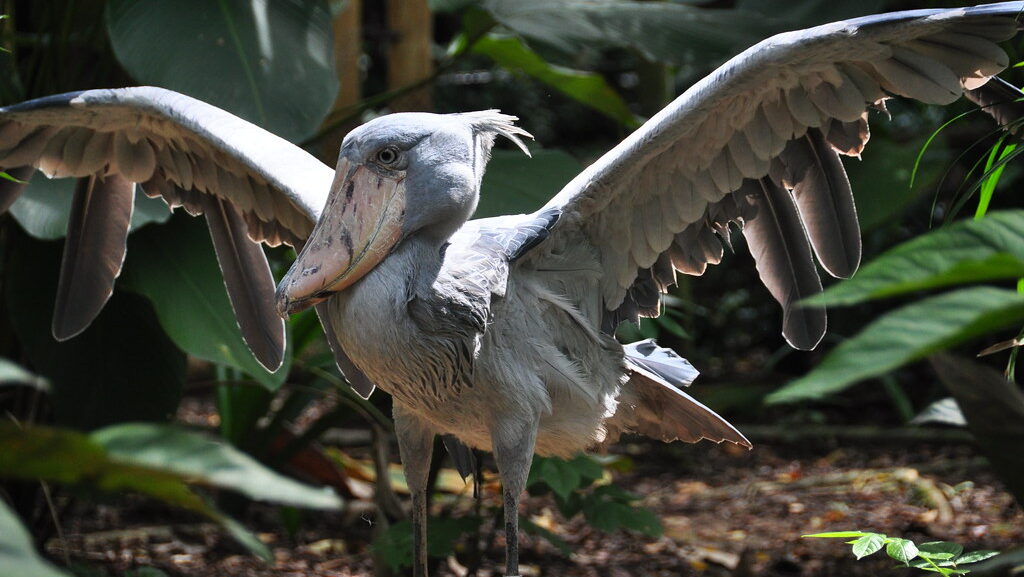
Beyond their hunting strategy, Shoebills exhibit numerous behavioral peculiarities that further distinguish them from other large wading birds. One of their most unusual habits is their tendency to defecate on their own legs, a behavior that serves as a cooling mechanism through evaporation in the hot African sun—a practice known as urohidrosis. Shoebills also demonstrate remarkable preening rituals, spreading their enormous wings to create shade that attracts fish seeking relief from the sun, thereby potentially aiding their hunting success. When threatened, rather than immediately fleeing, Shoebills often adopt a threat display where they spread their enormous wings, pump their head forward and backward, and clatter their bill loudly. Perhaps most endearing to human observers is their occasional response to people: when encountering humans who bow to them, Shoebills sometimes bow in return, creating the impression of a formal greeting that has made these interactions popular among wildlife tourists.
The Shoebill in Captivity: Challenges and Successes
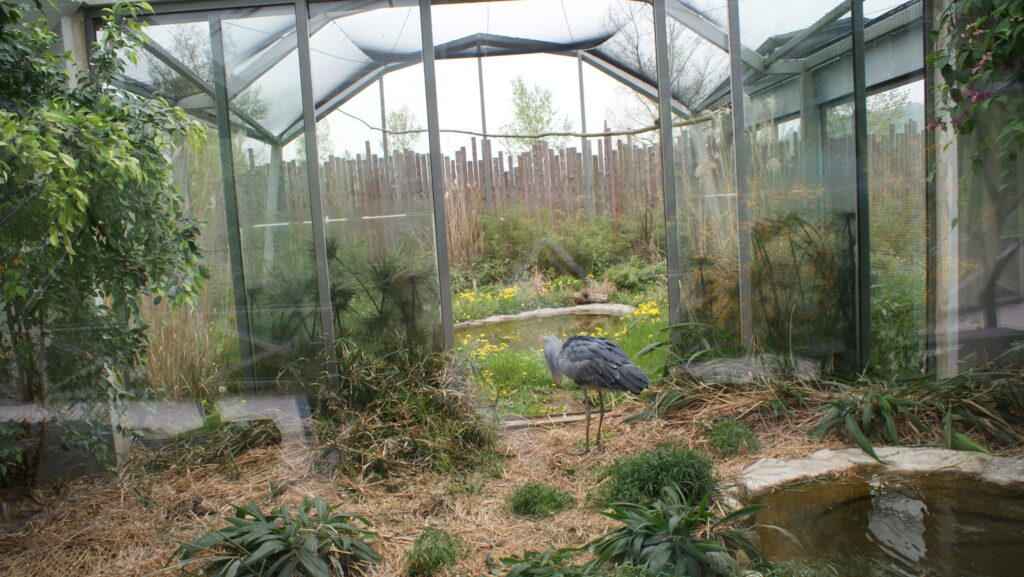
Keeping Shoebills in captivity presents extraordinary challenges, explaining why relatively few zoos worldwide house these remarkable birds. Their specialized diet, requiring large quantities of whole fish, makes them expensive to maintain compared to other large birds. Shoebills also require spacious enclosures with specific water features to approximate their natural habitat, including shallow pools and dense vegetation. Breeding success in captivity has been extremely limited, with only a handful of facilities worldwide having achieved successful reproduction. The Uganda Wildlife Education Centre represents one of the few success stories, having developed specialized husbandry techniques that have resulted in multiple successful breeding events. These captive breeding programs, while challenging, provide important insurance populations should wild Shoebill numbers continue to decline, as well as valuable opportunities for research and public education about these remarkable birds.
Ecotourism Impact: Viewing the “Dinosaur Bird”
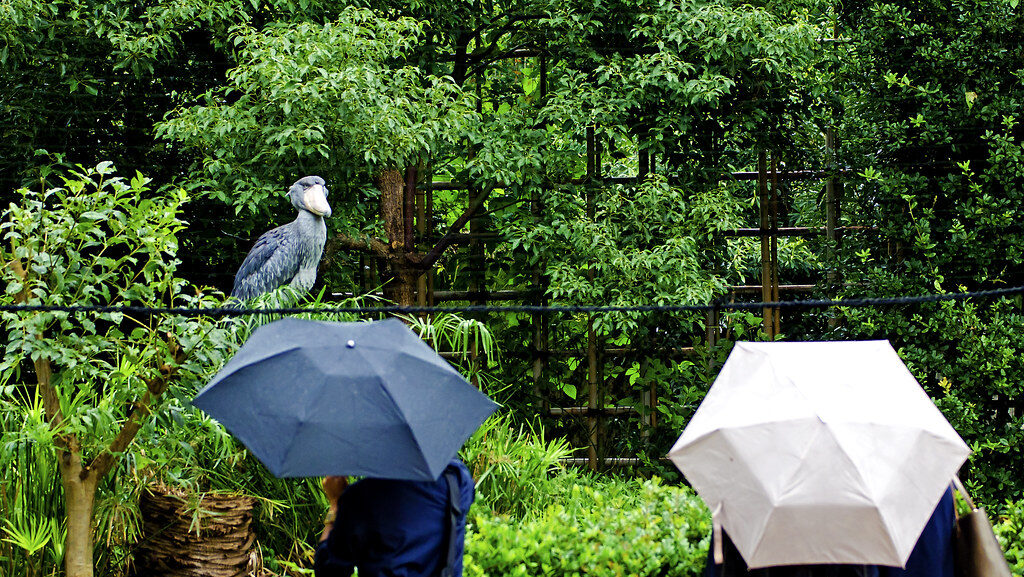
The Shoebill’s prehistoric appearance and rarity have made it a premier target for wildlife enthusiasts, creating a growing ecotourism industry centered around viewing these remarkable birds. Prime viewing locations include Uganda’s Mabamba Bay on Lake Victoria and Zambia’s Bangweulu Wetlands, where specialized boat trips take visitors into remote swamps to search for Shoebills. This ecotourism has created economic incentives for conservation, with local guides and communities benefiting from tourism revenue that depends on healthy Shoebill populations. However, poorly managed tourism can create its own pressures, with boats sometimes approaching too closely and disturbing natural behaviors. The most successful Shoebill tourism initiatives have implemented strict viewing guidelines, including maintaining minimum distances, limiting group sizes, and ensuring that a portion of revenue directly supports conservation efforts and local communities who serve as the primary guardians of these birds.
Future Prospects: Can the Shoebill Survive the Anthropocene?
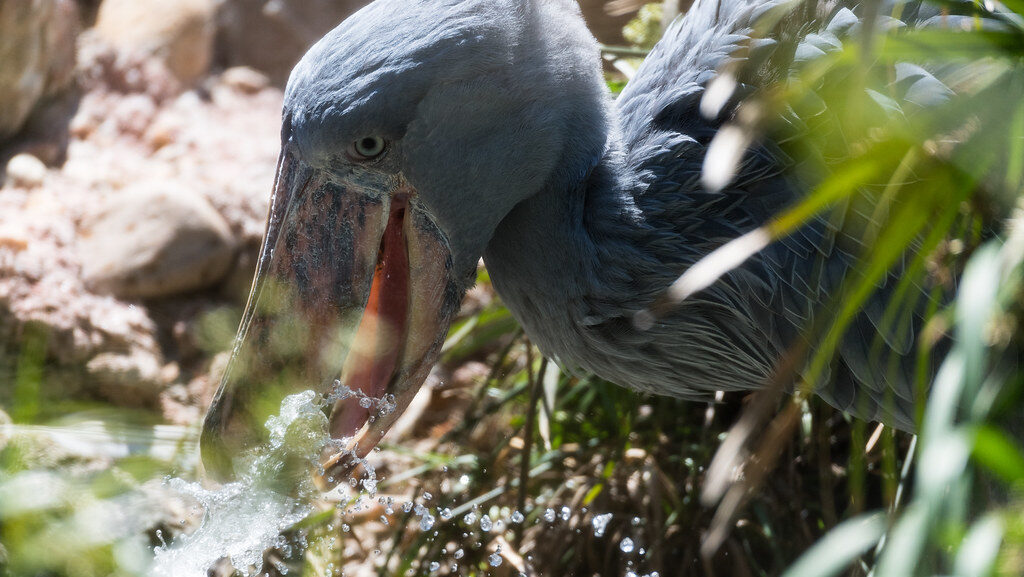
The future of the Shoebill remains uncertain as these specialized birds face mounting pressures in the Anthropocene era. Their reliance on vast, undisturbed wetlands places them in direct competition with human development, particularly as Africa’s population continues to grow and demand for agricultural land increases. Climate projections for East Africa suggest increasingly unpredictable rainfall patterns that could fundamentally alter the hydrology of Shoebill habitat, potentially creating seasonal mismatches between breeding cycles and optimal conditions. Despite these challenges, there are reasons for cautious optimism about the Shoebill’s future. International conservation attention has increased significantly, with specialized action plans developed specifically for Shoebill conservation across their range. Advanced tracking technologies, including satellite transmitters, are providing unprecedented insights into Shoebill movements and habitat use, allowing for more targeted conservation efforts. The future of this living fossil ultimately depends on humanity’s collective willingness to value and protect the wild spaces these magnificent birds call home.
Conclusion
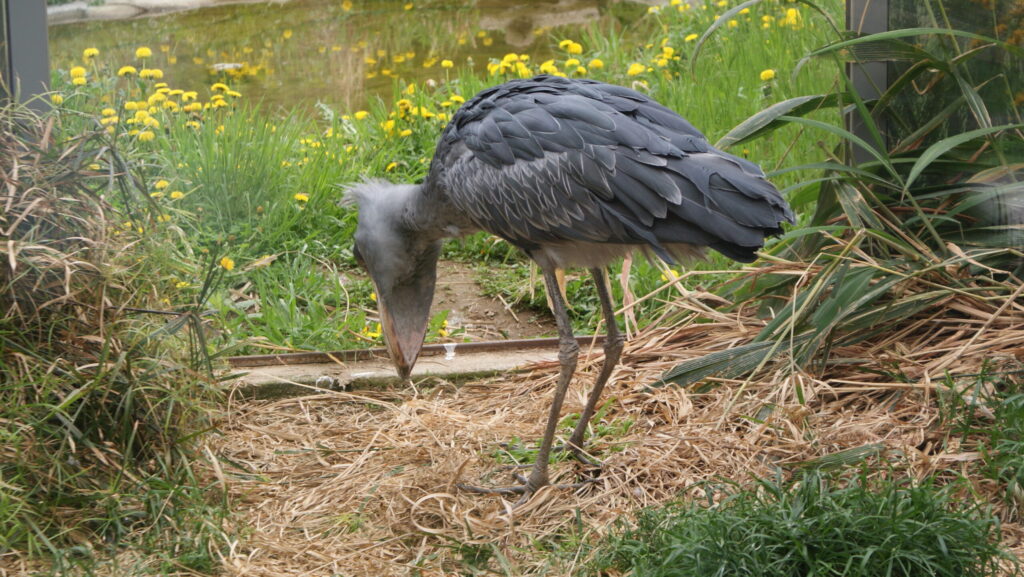
The Shoebill stands as one of nature’s most remarkable creations—a living link to prehistoric times that continues to captivate and mystify. With its massive bill, patient hunting strategy, and complex parental behaviors, it represents evolutionary specialization taken to extraordinary lengths. As we face the realities of a rapidly changing planet, the fate of the Shoebill serves as both warning and inspiration. These magnificent birds remind us of nature’s remarkable capacity for specialized adaptation while simultaneously highlighting the vulnerability that often accompanies such specialization. Through continued research, dedicated conservation, and sustainable ecotourism, we can work to ensure that future generations will still have the opportunity to marvel at this extraordinary “whale-headed stork”—a true living fossil and one of Africa’s most iconic natural treasures.
